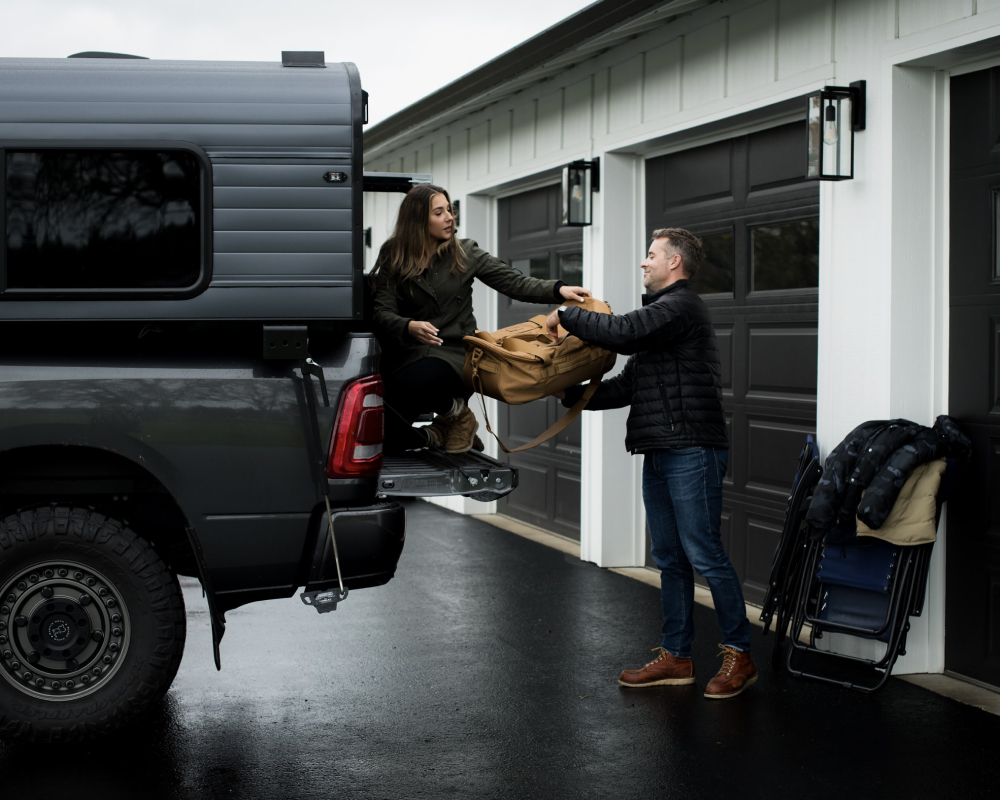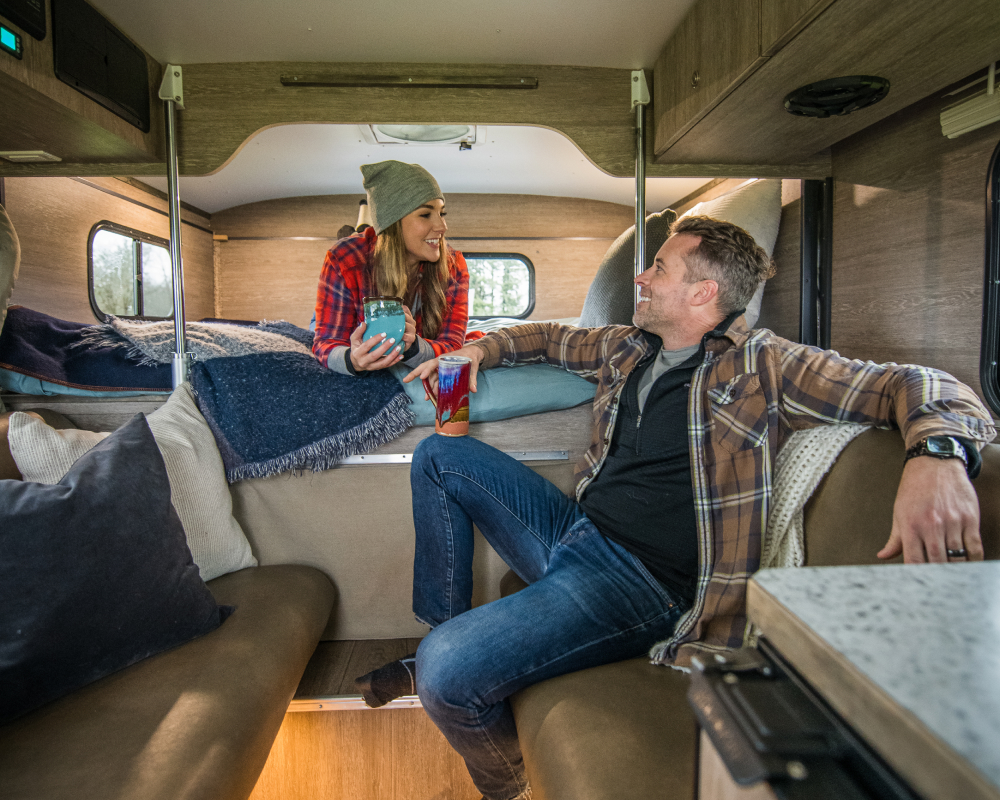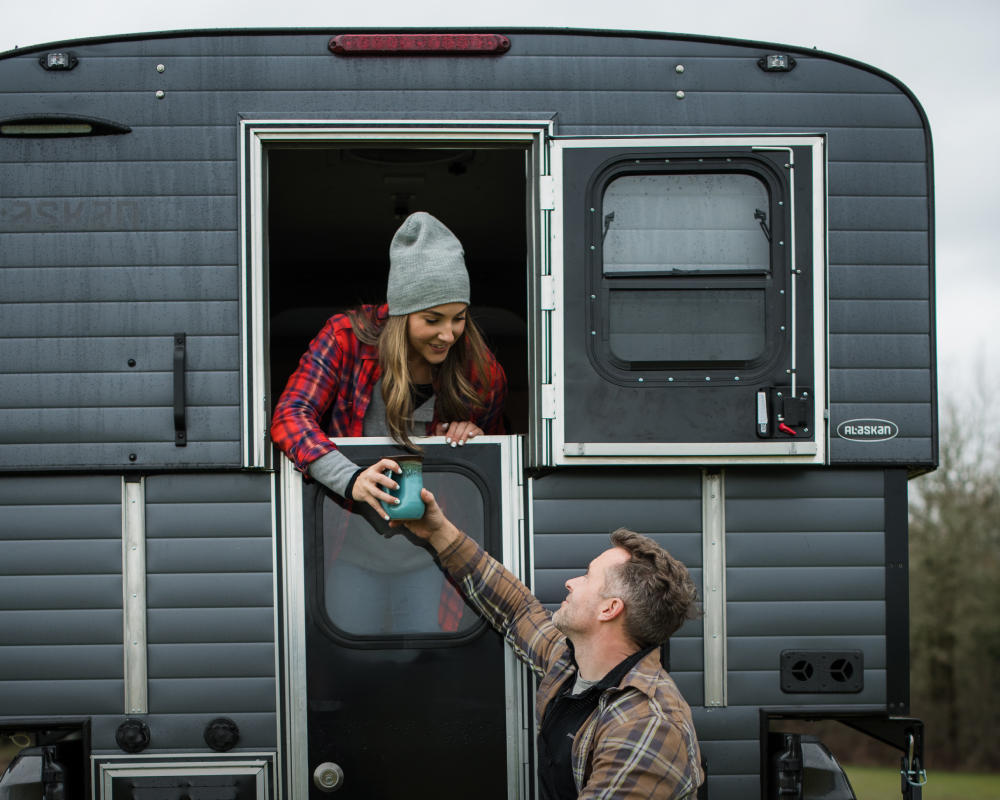Gearing Up for Winter Camping
The right gear is crucial for winter camping, so let’s go over the must-haves
If you’re anything like us, gearing up for a new hobby or season you’re not used to can be pretty fun. While it’s ridiculous to be “that person” with all the new, expensive gear and not a clue about the actual pastime, researching and finding quality items that really enhance your experience is worth talking about. When it comes to winter camping, sure, you could stay home and huddle up in front of the fire, but nothing compares to the freedom and thrill of camping in the cold—especially when you know you’ve got the right gear to keep you warm and comfortable. Whether you’re staying cozy inside your camper or deciding to rough it with a night outside, here’s everything you’ll need to make this season’s chilly months more enjoyable. To be completely transparent, we’re going to recommend some brands along the way (it’s hard not to), but we’re not affiliated with any of these companies. These are simply products we’ve trusted and shared with others during our travels. Now that we’ve got that out of the way, let’s get started.

Bedding: Inside and Outdoors
Choosing the right sleeping bag is essential for staying warm during winter camping. Temperature ratings play a key role in determining what bag is best for your needs. For extreme cold, look for a bag rated for at least -20°F—these higher-rated down bags are designed for harsh, freezing conditions, but they often come at a higher price. For a more budget-friendly option, consider a bag rated for 0°F, like the Coleman North Rim. Its synthetic fill retains warmth even in damp conditions, making it perfect for cold-weather camping. If you’re expecting “milder” winter nights, a 15°F-rated sleeping bag, like the REI Co-op Magma, provides great warmth without the bulk.
However, if you’re sleeping inside your Alaskan Camper, you’ll likely be boiling in one of these bags. The built-in 20,000 BTU Suburban Forced Air Furnace is designed to keep you comfortably warm, and these sleeping bags are meant for outdoor use in much colder conditions. For sleeping inside the camper, consider lighter alternatives like a sleeping bag rated for 35°F or higher, or even a sleeping bag liner combined with a cozy wool blanket. A down blanket or fleece throw could also be great for layering over your bag, providing warmth without overheating. These options will give you the comfort you need without feeling like you’re trapped in a sauna.
If you are heading out to winter tent camp (and you’re crazy, but you already know that), we’ve found that it’s most comfortable to pack both an inflatable sleeping pad and an insulated, closed-cell foam pad. The inflatable pad provides comfort and packs down small, while the foam pad adds extra insulation from the cold ground, ensuring you stay warm throughout the night. Using both pads, with their combined R-value, will help prevent heat loss to the snowy or frozen surface beneath you. For added warmth, consider bringing along a wool blanket or two—Merino wool is especially great for regulating body temperature. Wool not only keeps you warm but also wicks away moisture, so even if it gets damp, you’ll stay cozy. Layering a wool blanket over your sleeping bag can make a significant difference, providing that extra bit of warmth on chilly nights.

Clothing: Layering and Essentials
When it comes to winter camping, the right clothing can make all the difference between a comfortable adventure and a miserable one. While the Alaskan Camper keeps you cozy inside, venturing outdoors requires careful layering to stay warm, dry, and mobile.
Start with the base layer—this is the foundation of your warmth. Look for moisture-wicking materials like Merino wool or synthetic fabrics. These materials are designed to pull sweat away from your skin, helping you stay dry and warm. A good base layer should be snug but not restrictive, allowing for free movement while efficiently managing moisture. Avoid cotton at all costs, as it retains moisture and can chill your body in the cold.
Next, layer an insulating mid-layer to trap your body heat. Fleece, down, or synthetic insulated jackets are great options here. A fleece vest can be particularly useful for keeping your core warm without adding too much bulk, allowing for better flexibility when you’re on the move. Down insulation provides excellent warmth-to-weight ratio, but if you’re expecting wet conditions, synthetic insulation is a more reliable option, as it retains warmth even when damp. Be mindful that this layer should allow you to add or remove clothing as conditions change throughout the day.
A weatherproof outer layer is crucial when braving the elements. Look for jackets or shells made from breathable, waterproof materials like Gore-Tex or other advanced membranes. These fabrics will keep you dry while allowing moisture from sweat to escape. It’s worth investing in a jacket with adjustable cuffs, hoods, and vents to customize airflow as you need it. And don’t forget a neck gaiter or scarf to protect your face and neck from biting wind, along with a beanie or hat to trap warmth at the top of your body.
Insulated gloves or mittens are a must for winter camping—mittens keep your fingers together for extra warmth, but if you need dexterity, choose gloves with a good balance of insulation. Add wool or synthetic liner gloves for extra warmth on particularly cold days. For your feet, start with Merino wool socks, which wick moisture and keep your feet warm without being too bulky. If you’re facing deep snow or extreme cold, insulated, waterproof boots are key to keeping your feet dry and warm. For extra comfort at night, consider heated insoles or foot warmers.

Water, Sun Protection, and Instant Warmth
Water is essential when you’re braving the cold (okay, it’s essential all the time), but it can freeze faster than you can zip up your jacket when temperatures drop. Inside your Alaskan Camper, you’re covered—the insulated floors and walls keep your water from freezing. But once you step outside, that’s when the real challenge begins. If you’re melting snow for water, always add a little water to your pot before dumping in the snow. It helps prevent the snow from burning and gives you that cleaner, fresher taste. For carrying water, go for an insulated reservoir like the CamelBak Crux or a large, durable 5-gallon water carrier to keep your supply accessible. A simple trick to avoid freezing is to store your water bottles upside down—since water freezes from the top down, this helps prevent your entire bottle from becoming a solid block of ice.
It’s easy to forget, but the sun’s power doesn’t take a winter break. Snow reflects UV rays, and you’d be surprised how quickly you can get burned, even on the coldest days. To stay protected, pack a high SPF sunscreen and always have lip balm on hand to shield your lips from the harsh wind and sun. Snow blindness can be a real risk, so make sure your sunglasses or goggles offer full UV protection—there’s nothing worse than struggling to see through the bright glare. To protect your face, bring a balaclava or neck gaiter to block the wind, and keep your skin covered to avoid both windburn and sunburn.
Staying warm is the key to enjoying the great outdoors—because let’s face it, nothing ruins a winter adventure faster than cold hands and feet. Instant heat packs are your best friend in this battle. Toss a few HotHands into your gloves, boots, or sleeping bag to keep your extremities toasty when you’re out in the cold for hours. These little packs are game-changers, offering reliable warmth in a pinch. Don’t stop there—heated insoles or foot warmers work like magic when temps stay low. If you’re not near a fire, layer thin socks under your wool ones to trap extra warmth. And for those cold nights, a hot water bottle in your sleeping bag is pure comfort—just seal it tightly and let it keep you warm while the cold stays outside.
Bundle Up and Call It Done
Winter camping is all about being prepared—get the right gear, layer up, and stay warm, and you’ll be set to enjoy the cold without the discomfort. Embrace the adventure, and let the elements be part of the fun! Until next week, stay warm!
